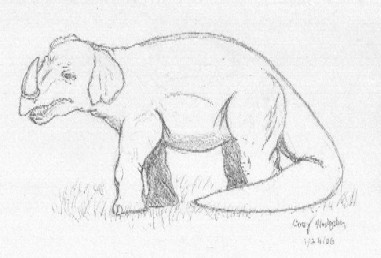Emela Ntouka Artwork
Posted by: Loren Coleman on January 26th, 2006
A Cryptomundo reader has sent along what they see in the native art shown previously here.
Thanks to Corey H. for sending this along.
Click on above image to see full-size version
About Loren Coleman
Loren Coleman is one of the world’s leading cryptozoologists, some say “the” leading living cryptozoologist. Certainly, he is acknowledged as the current living American researcher and writer who has most popularized cryptozoology in the late 20th and early 21st centuries.
Starting his fieldwork and investigations in 1960, after traveling and trekking extensively in pursuit of cryptozoological mysteries, Coleman began writing to share his experiences in 1969. An honorary member of Ivan T. Sanderson’s Society for the Investigation of the Unexplained in the 1970s, Coleman has been bestowed with similar honorary memberships of the North Idaho College Cryptozoology Club in 1983, and in subsequent years, that of the British Columbia Scientific Cryptozoology Club, CryptoSafari International, and other international organizations. He was also a Life Member and Benefactor of the International Society of Cryptozoology (now-defunct).
Loren Coleman’s daily blog, as a member of the Cryptomundo Team, served as an ongoing avenue of communication for the ever-growing body of cryptozoo news from 2005 through 2013. He returned as an infrequent contributor beginning Halloween week of 2015.
Coleman is the founder in 2003, and current director of the International Cryptozoology Museum in Portland, Maine.











This looks like an example of the chimera phenomenon due to the amalgamation of different animal characteristics that are easily identifiable, such as the rhino horn, elephant ears, elephant body, and crocodilian-like tail. I don’t think it is uncommon for cultures that revere and/or fear certain animals to begin combining animal features into mythological creations that serve either as totems or bogeymen; as an example the gryphon, sphinx, and pegasus. I’m no anthropologist, though. I’m just tossing this out there as a point-of-origin hypothesis.
Looks to me like a ceratopid, the “ears”, are the vestigial frill, and the rest just falls into place.
I’ve always considered the Emela Ntouka a likely form of rhinoceros as well, based on available information. Oddly, I’ve never seen any alternative proposals for Mokele M’Bembe other than that of a Sauropod, which, although I’d love for it to be, seems rather improbable. My thought, and maybe someone else has beaten me to it, I don’t know, is that perhaps it is a survival of Indricotherium or something similar. has anyone ever offered a picture of one of them amongst those of dinosaurs shown to the natives?
An Indricotherium would also seem to be a better match, morphologically, for the creature depicted on the Ishtar Gate in Babylon. I know it has since been translated differently, but I believe most people still know it as the sirrush. The scale motif has always struck me as ornamental (Not that I’ve ever seen a Dinosaur depicted with scales anyway).
I have to agree. Indricotheres were a giraffe-like species of rhino that did not have a horn. It was the largest land mammal ever, and certainly may be able to swim. As for the rhino theory for Emela Ntouka, I think it is possible, but the tail that Emela Ntouka has is way to long, and also too thick.
The beast on the Ishtar gate is likely mythological (notice the snake head, cat paws, and eagle talons, which is an impossible combination for a real animal) or an attempt to represent something known at best from secondhand accounts (you can see this kind of thing in medeival bestiaries as well).
If the builders of the Ishtar gate had never seen a real Indricothere, they may interpret it differently than a giant rhino with no horn.
Indricotheres had medium length heads, and short hoof-like nails. If they did not know all parts of any Indricotheres seen, they may put in parts of known animals to fill in gaps.
Could someone post a link to a picture of the Ishtar gate animal?
Check out the link in one of the comments on the supposed southeast Asian stegosaurid carving, it’s a creationist site, but it does have a picture of the gate in question…
Thanks, and it does resemble an Indricothere.